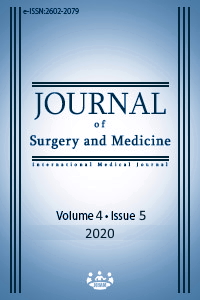Urinary incontinence frequency, type, severity, and risk factors in female patients undergoing physical rehabilitation: A single center experience
Keywords:
Urinary incontinence, Frequency, FemaleAbstract
Aim: Urinary incontinence (UI) is a health problem with important psychological, hygienic, and socio-economic consequences. The aim of this study is to determine the frequency, severity, and risk factors of urinary incontinence in women.
Methods: In this retrospective cohort study, we evaluated the frequency and risk factors of UI in 62 women over the age of 18 who were referred to the Physical Medicine and Rehabilitation outpatient clinic between August 2019 and February 2020. The data, socio-demographic characteristics of the patients and the results of the Urogenital Distress Inventory-6 (UDI-6) were analyzed.
Results: The mean age of 62 patients included in the study was 57.2 (15.4) years, with the mean duration of symptoms of 7.6 (4.82) years. Stress UI, urge UI and mixed UI were present in 28 (45.2%), 13 (20.9%), and 21 (33.9%) patients, respectively. UI was detected more frequently in patients over 40 years of age (30.6%) than in patients between the ages of 18 and 40 (69.4%) years, in those who gave birth at least once (80.7%) compared to those who had never given birth (19.3%), and in patients with Body Mass Index (BMI) values over 25 kg/m2 than in patients with BMIs between 18.5-25.0 kg/m2 (72.5% vs. 22.5%, respectively).
Conclusion: UI is an important health problem which negatively affects the quality of life of many women. Various socio-demographic and medical factors affect the frequency of urinary incontinence. Therefore, especially the elderly patient group should be informed of the treatability of this condition and be directed to a physician.
Downloads
References
Abrams P, Artibani W, Cardozo L, Dmochowski R, van Kerrebroeck P, Sand P. Reviewing the ICS 2002 terminology report: the ongoing debate. Neurourol Urodyn. 2009;28:287.
Wein AJ, Rovner ES. Definition and epidemiology of overactive bladder. Urology. 2002;60(5):7-12.
Stewart WF, Van Rooyen JB, Cundiff GW, Abrams P, Herzog AR, Corey R, et al. Prevalence and burden of overactive bladder in the United States. World J Urol. 2003;20(6):327-36.
Sandvik H, Hunskaar S, Vanvik A, Bratt H, Seim A, Hermstad R. Diagnostic classification of female urinary incontinence: An epidemiological survey corrected for validity. J Clin Epidemiol. 1995;48(3):339-43.
Hunskaar S, Burgio K, Diokno A, Herzog AR, Hjälmås K, Lapitan MC. Epidemiology and natural history of urinary incontinence in women. Urology. 2003;62:16-23.
Hampel C, Wienhold D, Benken N, Eggersmann C, Thuroff JW. Prevalence and natural history of female incontinence. Eur Urol. 1997;32:3-12.
Hagglund D, Olsson H, Leppert J. Urinary incontinence: An unexpected large problem among young females. Results from a population based study. Fam Pract. 1999;16(5):506-9.
Uebersax JS, Wyman JF, Shumaker SA, McClish DK, Fantl JA. Short forms to assess life quality and symptom distress for urinary incontinence in women: the Incontinence Impact Questionnaire and the Urogenital Distress Inventory. Continence Program for Women Research Group. Neurourology and Urodynamics. 1995;14:131-9.
Cam C, Sakalli M, Ay P, Cam M, Karateke A. Validation of the short forms of the incontinence impact questionnaire (IIQ-7) and the urogenital distress inventory (UDI-6) in a Turkish population. Neurourology and Urodynamics. 2007;26:129-33.
Faltin DL. Epidemiology and definition of female urinary incontinence. J Gynecol Obstet Biol Reprod (Paris). 2009;38:146-152.
Cerruto M, D’Elia C, Aloisi A, Fabrello M, Artibani W. Prevalence, incidence and obstetric factors’ impact on female urinary incontinence in Europe: a systematic review. Urologia Internationalis. 2012;3:1-9.
Hunskaar S, Lose G, Sykes D, Voss S. The prevalence of urinary incontinence in women in four European countries. BJU Int. 2004;93:324-30.
Gasquet I, Tcherny-Lessenot S, Gaudebout P, Bosio L, Goux B, Klein P, et al. Inluence of the severity of stress urinary incontinence on quality of life, health care seeking, and treatment: a national crosssectional survey. European Urology. 2006;50:818-5.
Peyrat L, Haillot O, Bruyere F, Boutin JM, Bertrand P, Lanson Y. Prevalence and risk factors of urinary incontinence in young and middle-aged women. BJU Int. 2002;89:61-6.
Sykes D, Castro R, Pons ME, Hampel C, Hunskaar S, Papanicolaou S, et al. Characteristics of female outpatients with urinary incontinence participating in a 6-month observational study in 14 European countries. Maturitas. 2005;52:13-23.
Zengin N. Kadınlarda idrar kaçırma prevelansı ve risk faktörleri. Fırat Sağlık Hizmetleri Dergisi. 2010;13:45-60.
Başak T, Uzun S, Arslan F. Incontinence features, risk factors and quality of life in Turkish women presenting at the hospital for urinary incontinence. J Wound Ostomy Continence Nurs. 2012;39:(1)84-9.
Milsom I. The Prevalence of Urinary Incontinence. Acta Obsterics and Gynecology. 2000;79:1056-9.
Thom, D. Variation in estimates of urinary incontinence prevalence in community: effects of differences in definition, population Characteristics, and study type. J Am Geriatr Soc. 1998;46:473-80.
Victurp L, Lose G, Rolff M, Barfoeed K. The symptom of stress incontinence caused by pregnancy or delivery in primiparas. Obstetrics and Gynecology. 1992;79:945-9.
Raimi TH, Odusan O. Association of hypertension with generalized obesity in rural south-western Nigeria. J Surg Med. 2020;4(3):177-81.
Bump RC, Sugerman HJ, Fantl JA, McClish DK. Obesity and lower urinary tract function in women effect of surgically induced weight loss. Am J Obstet Gynecol. 1992;167:392-9.
Dwyer PL. Lee ETC, Hay DM. Obesity and urinary incontinence in woman. Br Obstet Gynecol. 1988;95:91-6.
Luna MT, Hirakawa T, Nakano H. Urinary inkontinance in women seen in the obstetrics and gynecology clinic. Int Urogynecol J Pelvic Flor Dysfunct. 2000;11(5):277-81.
Özerdoğan N, Kızılkaya NB. Eskişehir, Bilecik, Afyon, Kütahya illerinde 20 yaş ve üstü kadınlarda üriner inkontinansın prevelansı, risk faktörleri, yaşam kalitesine etkisi. Hemşirelik Dergisi. 2003;13:37-50.
Downloads
- 562 981
Published
Issue
Section
How to Cite
License
Copyright (c) 2020 Ayşe Berhoğlu, Osman Barut
This work is licensed under a Creative Commons Attribution-NonCommercial-NoDerivatives 4.0 International License.
















